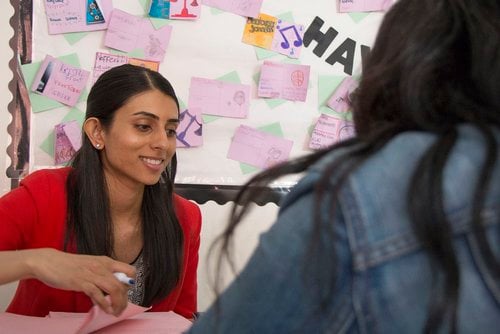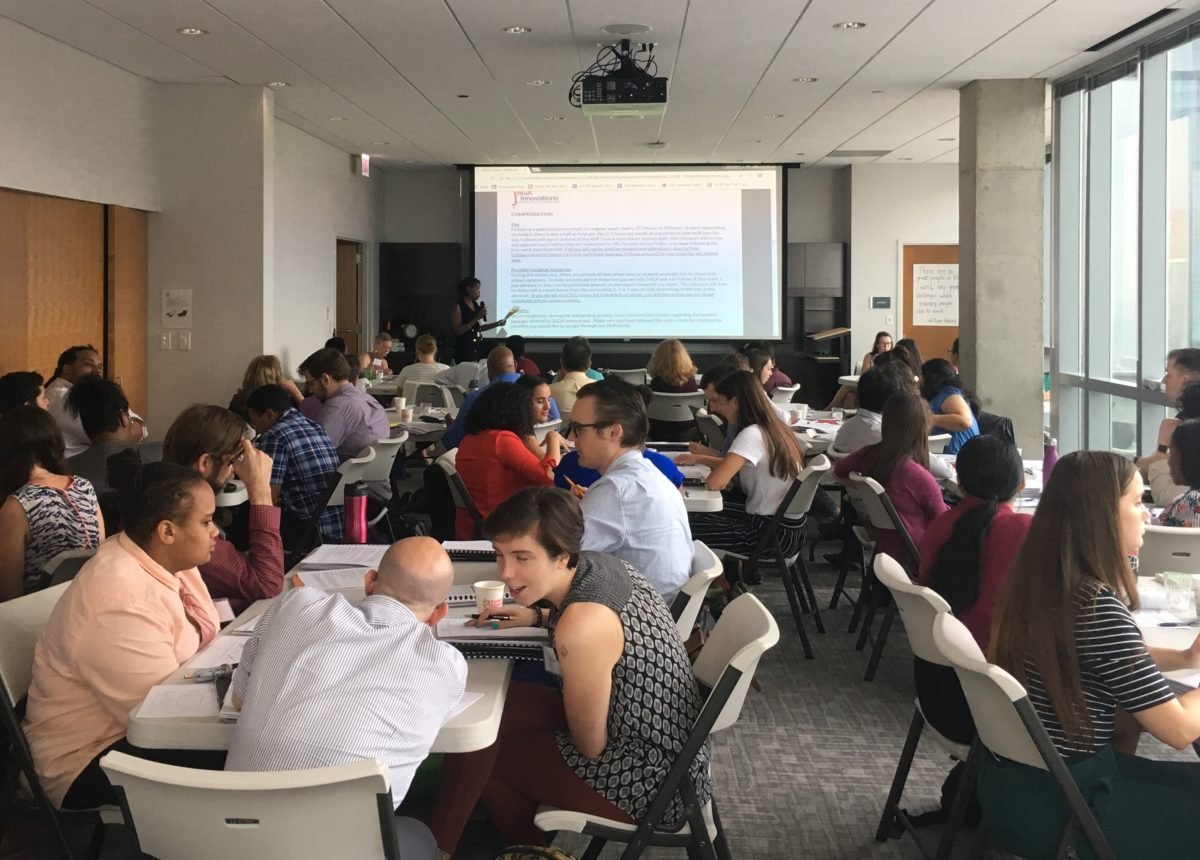At Saga Education, we are on a mission to eliminate educational inequity, by providing personalized and consistent tutorials for students, resulting in youth gaining confidence and academic strength.
Research has shown that individualized tutoring can help students who have fallen behind catch up. However, successfully deploying a tutoring program within a school or school district can be incredibly challenging without proper planning and consideration.
The 4+2+1 Perspective: Purpose
Saga Education Co-Founder and President, Alan Safran developed the “4+2+1” Perspective, a framework to better set up school districts, schools, tutors, and students for success when launching a tutoring program.
The 4+2+1 Perspective: Goal
The goal of this framework is to support school districts in deploying tutoring programs, something many don’t have experience doing.
What does the 4+2+1 Perspective consist of?
We’ve established 7 matters that schools and districts need to consider before they use all new federal, state, or philanthropic money to start up a tutoring program. The name comes from the 4 primary + 2 secondary + 1 systems change matters.
4 are primary: program design, human capital, training, and curriculum
+
2 are secondary: communications plan, measurement
+
1 is a systemic change issue: funding
4 Primary Matters:
1. Program Design
The first consideration is program design—when tutoring will be offered, the frequency of tutoring, determining which students will receive tutoring, and whether tutoring time will be a class for credit.
To start, will tutoring be offered within the school day or out of regular school time?
Evidence shows that there is greater success when tutoring is part of the school day, as it allows for more connections to teachers.
After school tutoring is generally an “after-school afterthought.” For example, the tutor may show up, but the student may not have been in school that day causing frustration, or the student may not have their book or class notes, leaving the tutor unsure what to focus on for the session.
In determining which students will receive tutoring and how frequently, and which grades should be prioritized, Saga has found that grade-3 reading proficiency and grade-9 math success are vital. Evidence is clear that kids who are proficient in reading by grade 3, have a 4 times greater chance at earning a high school diploma. Additionally, students who pass Algebra I in 9th grade have a 4 times greater chance at earning a high school diploma than those who don’t pass.1
Another essential aspect to consider in program design is dosage, or the frequency of tutoring. Saga recommends high-dosage tutoring, which means every other day at a minimum or every day as a maximum. It’s especially important to have tutoring as a regular class period, as opposed to 10 minutes here and there. Schools should assess the school schedule, and consider rearranging or extending the day to accommodate the time.
2. Human Capital
The next primary matter to address is human capital, or the people strategy. This includes determining whom to recruit as tutors and how.

Will the tutors be the school’s own teachers or staff? Outside paid tutors or volunteers?
For best results, it’s ideal to have full-time tutors, as current teachers are already pulled in too many directions to make out-of-class tutoring a priority. Part-time teachers can be a good option, as they gain experience working one-one-one with students, but logistically, scheduling them on a part-time basis can be more of a hassle. Also, it’s difficult for them to get regular feedback from students.
We recommend having full-time tutors to allow for regular feedback, and in turn, better on the job training.
When it comes to recruiting tutors, how do you find, select, and onboard them? What qualifications must tutors have on day one?
Saga is here to provide hands-on consulting and technical assistance to help organizations in developing and implementing high-impact tutoring programs from design, to tutor recruitment and selection, tutor training, program management, curriculum design, and ongoing assessments to identify student’s knowledge and skills gaps. Sign up for Saga Consult to learn more.
3. Training
Before a tutor is hired, there needs to be a plan for pre-service training. If tutors are not set up for success from the start, they are guaranteed to have problems along the way. This training should include what tutors will be teaching or reviewing, and how they can be effective tutors. We have created a free, self-paced tutor training portal called Saga Coach to address this need.
When most tutors are starting out with their students, they feel that talking a lot shows how much they know and is a key to effective teaching. In fact, the opposite is true. Tutors should spend 70% of their time watching their students struggle productively, or in other words, allowing students to try to solve problems on their own.

Pre-service training is vital, and so is in-service coaching. Schools and districts need to determine who provides tutors training/coaching, how frequently it will be offered, what happens if a tutor doesn’t improve with coaching, and what’s the strategy throughout the school year in terms of coaching up tutors to become more effective or to moving them out.
4. Curriculum
Schools must determine what curriculum to provide tutors, as the teacher curriculum is not tutor friendly. A tutor-specific curriculum is optimal, as it ensures that both the student and the tutor can succeed. For seven years, Saga has developed this for grades 6, 9, 10 and 11 in math, getting feedback over the years from tutors and students. There is no better substitution for something created by tutors for tutors. Tutors will be able to follow what teachers are doing after a day or two, and reinforce learning when tutoring. Our curriculum is available for free to interested districts.
Once schools and districts address the four primary matters, they should be able to begin shaping their execution plan. This includes the three secondary matters that are important for long-term success.
These two secondary matters to consider are:
1. Communications Plan
In order for any school tutoring program to be successful, there needs to be clear communication between schools, tutors, teachers, staff, parents, and students.
Schools and districts must have a plan for explaining the role and value of tutors as a supplemental resource and not as a replacement to teachers, and for regularly sharing feedback regarding students’ performance.
Some questions to answer are how will the schools communicate with the teachers, parents, and students, and how will tutors communicate with them.
At Saga, tutors communicate with parents at least once a month, which helps parents feel more involved in their child’s learning.
2. Measurement
Schools and districts should have clearly defined metrics to measure the success of a tutoring program. Some potential metrics could be comparisons of grades among tutored versus non-tutored students in the same year or compared to prior year’s cohort, baseline assessments that can retest for growth, or surveys of students, tutors, and families.
Having measures of success helps schools know if tutors are getting better at their job, and more importantly, if students are gaining greater confidence in their work and becoming more proficient in the subject matter.
This is the systemic change issue to keep in mind:
1. Funding
The final matter to take into consideration is funding. If the initial funding for the tutoring program only covers the short-term, and if the program is successful, what is the long-term plan to sustain the program?
Federal stimulus is significant, with schools and districts having anything from $4,000 - $20,000 in spending over the next several years. Yet, the core issue that schools face is what they will do when that money ends. We recommend that schools and districts have a plan for funding to sustain a tutoring program after the stimulus funds end in 2023.
Regardless of whether or not there is a pandemic facing the nation, there have always been significant challenges in public education in America. Kids enter the 9th grade on average three years behind grade level. If tutoring is seen as just a temporary intervention, and then we go back to business as usual, we’ve missed an opportunity to really make a sustained difference for the future. Schools should consider early on how to reshape their budgets, schedules and human capital deployment to build tutoring into their day after 2023.
Takeaway
The 4+2+1 Perspective is an evidence-based framework for achieving the goal of getting all kids to achieve a higher level, no matter their socio-economic background, school, or district. Our tutoring system at Saga Education helps students develop strong connections with their tutors, consistently give and receive feedback, enjoy a personalized curriculum, and ultimately succeed.
If your school or district is looking to set up a high-impact tutoring program, please don’t hesitate to reach out to Saga Education for assistance with program management and implementation, and check out Saga Direct.
